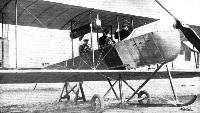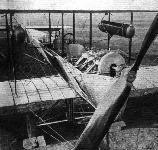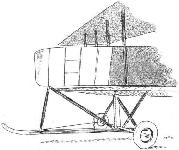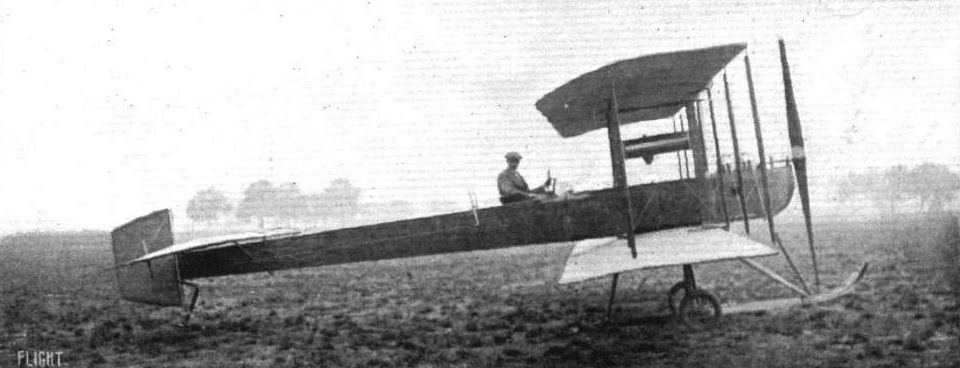L.Opdyke French Aeroplanes Before the Great War (Schiffer)
Deleted by request of (c)Schiffer Publishing
Astra Type C: The first typically Astra design first appeared in 1910 and flew in August 1911. It was built in small numbers through 1913, a 2-seater first of wood and later of steel and wood. It had the long triangular-section fuselage and cross-axle-and-post undercarriage of the Antoinettes.
(Span: 12.5 m; length: 10.4 m; wing area: c 48 sqm; empty weight: 500 kg; gross weight: 800 kg; speed 81 kmh; 60 hp Chenu)
Astra Type CM: Type C was developed as the military CM, with 3 seats, rounder wingtips and wider wings; more metal was used in the frame.
(Span: 12.32 m; length: 10.95 m; empty weight: 673 kg; gross weight: 1000 kg; speed: 85 kmh; 80 hp Chenu, or an 85 hp air-cooled Renault)
Jane's All The World Aircraft 1913
ASTRA. "Astra" Soc. de Constructions Aeronautiques, (Anciens Etabs. Surcouf) Soc. An'yme 13 Rue Couchat, Billancourt (Seine). Works: 121-123 Rue de Bellevue, Billancourt. Flying grounds: Issy-les-Molineux Villacoublay (S-&-0). This old established balloon and dirigible firm first took up aviation as French agents for the Wrights in 1909. For a time they built Wrights with certain modifications, but by 1912, little save the Wright system of warping remained. Capacity: about 100 machines a year.
Biplane, Military Biplane, Mil. biplane, Hydro-bi-
type C. biplane Type C. type C.M. plane,type
1912-13. type C.M. 1913. 1913. C.M.
Wood. 1912-13. Wood & Wood & steel. 1913.
Wood steel. Wood & steel
Length..feet(m.) 34 (10.40) 36 (10.97) 34 (10.40) 36 (10.97) 32? (10)
Span....feet(m.) 41 (12.50) 40? (12.32) 41 (12.50) 40? (12.32) 39? (12)
Area.sq.feet(m?) 519 (48.2) 519 (48.2) 519 (48.2) 519 (48.2) 519 (48.2)
Weight, machine,
......lbs.(kgs.) 1764 (800) 2365 (1073) ... 1411 (640) 1763 (800)
Weight, useful, (unladen)
......lbs.(kgs.) 661 (300) 882 (400) ... ... ...
Motor......h.p. 50 Renault 75 Renault 50 Renault 75 Renault 100 Renault
or 75 Chenu
Speed, max.,
....m.p.h.(km.) 56 (90) 56 (90) 56 (90) 56 (90) 56 (90)
Speed, min.,
......p.h.(km.) ... ... ... ... ...
Endurance..hrs. ... ... ... ... ...
Number built
during 1912 ... ... ... ... ...
Remarks.--The 1912-13 and 1913 types differ only in the adoption of metal in the 1913 models, which are consequently considerably lighter.
General features.--Warping wings. Fixed tail planes with two elevators in rear. Single rudder. Single tractor geared down 1 to 2. Type C carries 85 litres petrol; type C.M., 137 litres.
Журнал Flight
Flight, September 9, 1911.
FOREIGN AVIATION NEWS.
The Astra Triplane at Issy.
BOTH the new biplane and the triplane produced by the Astra Works have been tested nearly every day during the past week at Issy. Only straight flights have been made with the triplane, but the double-decker was taken round the ground several times on Monday by Goffin, who is conducting the tests.
Flight, December 30, 1911.
PARIS AERO SHOW.
Astra.
THIS interesting three-seater tractor biplane, which made its appearance in the French aviation arena just prior to the Military Trials at Rheims, gives me an impression of immense strength, solidity, and power when compared with those light speed craft which form such a great percentage of the exhibits at the Salon. Its fuselage, which is divided and made detachable for convenience of transport at a point to the rear of the pilot's seat, is triangular in section, and built throughout in ash, with the exception of the forward portion, which is cross-strutted with drilled-out steel struts of C section, so provided to strengthen the body to withstand the extra strains imposed upon it by the motor - a 100-h.p. six-cylinder Chenu. This latter drives an 8-ft. Astra tractor screw through reduction gearing. Radiators for the cooling of the motor are disposed on each side of the body in the neighbourhood of the middle seat.
The main planes, double surfaced, are built up cellular fashion and are so constructed that they may be detached, leaving a centre section about 7 ft. in width in order that the machine may be easily transported along the road.
Warping is employed for the correction of lateral balance, this being carried out on the Wrights' system, under whose licence the Astra machines are made.
The landing gear is somewhat reminiscent of Antoinette practice, and has the triple advantage of being simple, strong and presenting little head resistance. Landing shocks are taken by a large diameter Oleo pneumatic spring that forms the centre unit of the chassis. In common with many other types of landing gear at the Salon, no provision has been made to relieve any strains resulting from a sideways movement of the machine on landing, and the fact that so many designers are apparently ignoring this detail, which has hitherto been deemed a most important one, seems to demonstrate that the constructional difficulties of obtaining this accommodation for sideways strains altogether outbalances any advantages that might accrue from its adoption.
Command is maintained over the controlling surfaces from duplicated controls arranged for the use of the occupants of the two rear seats. The duty of the occupant of the forward seat is to act as observer and for this purpose he is most conveniently placed.
There was also exhibited on the Astra stand a dirigible nacelle equipped with two Chenu motors, each of 100-h. p.
Principal dimensions, &c. :-
Length 36 ft.; Weight 1,540 lbs.
Span 40 ft.; Speed 56 m.p.h.
Area 528 sq. ft.; Motor 100-h.p. Chenu.
Price L1,120
Flight, November 16, 1912.
THE PARIS AERO SALON.
Astra.
THE main differences in this year's Astra machine as compared with the one that figured at last year's Salon, are that it is equipped for water-flying and that steel has been employed largely in its construction. Wood is, in fact, very little used, for only the ribs of the main planes and the floats are constructed of it. The main body as before, is of triangular section, but, this year, it is built up of steel tubes, acetylene welded and braced with piano wire. To it in front are attached by more steel tubes, two massive wooden floats of Tellier construction. In the wings, large diameter steel tubes have replaced the old pattern wood spars, and over them the ribs are loosely jointed in such a manner that the warping works with extraordinary freedom. The old system of Wright wing flexing and strut attachment is retained. There are seats for three, the front one being for the observer, and the two to the rear being for pilots, each of whom is provided with controls. Fitted with a 12-cylinder Renault engine of 100-h.p., it looks a machine for serious work. M. Maurice Herbster, who was kind enough to explain its various paints to us, gave out a hint that the British Admiralty were considering ordering quite a number.
 |
Журнал - Flight за 1911 г.
|
| The Astra Company have just produced a biplane in which the monoplane type of body is the principal characteristic. The above side view, taken at Villacoublay, gives a very good idea of the arrangement of the new machine.
|
 |
Журнал - Flight за 1911 г.
|
| The latest Model Astra Biplane, which is representing the Societe Astra at the French Military Tests. - This machine, with the exception of the landing chassis, which is reminiscent of Antoinette practice, has a striking resemblance to the Avro biplane. It is furnished with double control, and the propulsive effort is obtained from a 75-h.p. Renault motor driving at half speed a "Normale" propeller. It will be noticed that the Horatio Phillips wing cross-section, brought into prominence by the late Edouard Nieuport, has been made use of.
|
 |
Jane's All The World Aircraft 1913 /Jane's/
|
| ASTRA. Military "C.M." 1913.
|
 |
L.Opdyke - French Aeroplanes Before the Great War /Schiffer/
|
| The Astra CM with 3 seats; it rather resembles a biplane Antoinette.
|
 |
Журнал - Flight за 1911 г.
|
| This photograph of the new Astra biplane, which is upholding the credit of that firm in the French Military Tests, gives a good idea of the general disposition of this interesting machine. Seating accommodation is provided for three, one of whom has a seat right in front for observation purposes, while the two seated in tandem behind him are each provided with controls. The motor is an 80-h.p. 6-cyl. Chenu, and drives a large diameter tractor-screw through reduction gearing.
|
 |
Журнал - Flight за 1911 г.
|
| Front of the Astra biplane, showing the general disposition of the under-carriage.
|
 |
Журнал - Flight за 1912 г.
|
| The 100-h.p. Astra hydro-biplane.
|
 |
Журнал - Flight за 1913 г.
|
| HYDRO-AEROPLANES. - Fig. 5. - Types of Aeroplanes.
|









